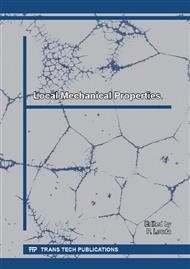[1]
C. G. Mc Kamey, Iron Aluminides, Physical Metalurgy and processing of Intermetallic Compounds. 1994, 351 – 391.
Google Scholar
[2]
N. S. Stoloff, Iron aluminides: present status and future prospects, Materials Science and Engineering A258. 1998, 1 – 14.
DOI: 10.1016/s0921-5093(98)00909-5
Google Scholar
[3]
S. C. Deevi, V. K. Sikka, Nickel and iron aluminides: an overview on properties, processing and applications, Intermetallics. 4 (1996), 357 – 375.
DOI: 10.1016/0966-9795(95)00056-9
Google Scholar
[4]
M. Palm, Concepts derived from phase diagram studies for the strengthening of Fe – Al-based alloys, Intermetallics. 13 (2005), 1286 – 1295.
DOI: 10.1016/j.intermet.2004.10.015
Google Scholar
[5]
D. G. Morris, Possibilities for high – temperature strengthening in iron aluminides, Intermetallics. 6 (1998), 753 – 758.
DOI: 10.1016/s0966-9795(98)00028-4
Google Scholar
[6]
M. Palm, A. Schneider, F. Stein, G. Sauthoff, Strengthening of iron aluminide alloys for high-temperature applications, Mater. Res. Soc. Symp. Proc. Vol. 842 (2005), S1. 7. 1 – S1. 7. 12.
DOI: 10.1557/proc-842-s1.7
Google Scholar
[7]
F. Píšek, Nauka o materiálu II., second ed., Československa akademie ved Publishing, Praha.
Google Scholar
[8]
Netsch. Horizontal pushrod dilatometer - product brochures [cit. 2012-10-30]. Available: http: /www. netzsch-thermal-analysis. com/uploads/tx_nxnetzschmedia/files/DIL_E_0313_10. pdf.
Google Scholar
[9]
M. Švec, E. Macajová, The coefficient of thermal expansion of Fe3Al and FeAl-type iron aluminides, Metal 2015. ISBN 978-80-87294-58-1.
Google Scholar
[10]
S. Kanagaraj, S. Pattanayak, Measurement of the thermal expansion of metal and FRPs, Cryogenic. Vol. 43, No. 7 (2003), 399-424.
DOI: 10.1016/s0011-2275(03)00096-1
Google Scholar
[11]
W. D. Porter, P. J. Maziasz, Thermal expansion data on several iron-and nickel-aluminide alloys, Scripta Metallurgica et Materialia. Vol. 29, No. 8 (1993), 1043-1048.
DOI: 10.1016/0956-716x(93)90175-r
Google Scholar
[12]
O. Prymak, F. Stein, Solidification and high-temperature phase equilibria in the Fe-Al-rich part of the Fe-Al-Nb system, Intermetallics. 18 (2010), 1322 –1326.
DOI: 10.1016/j.intermet.2009.12.022
Google Scholar
[13]
M. Švec, P. Kejzlar, The influence of heat-treatment on the phase composition and coefficient of thermal expansion of Fe3Al-type alloy with niobium addition, Aluminium a neželezné kovy. (2015).
DOI: 10.21062/ujep/x.2015/a/1213-2489/mt/15/4/705
Google Scholar
[14]
M. Švec, V. Vodičková, P. Hanus, The effect of phase composition and distribution on coefficient thermal expansion of Fe3Al based iron aluminides, Metal. 2014. ISBN 978-80-87294-52-9.
DOI: 10.21062/ujep/x.2013/a/1213-2489/mt/13/3/399
Google Scholar


